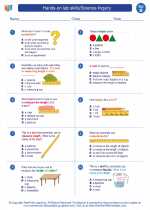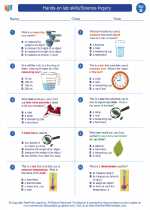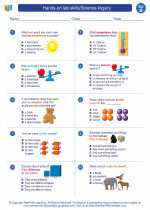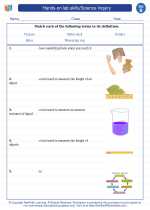Plants
Plants are living organisms that belong to the kingdom Plantae. They are essential for life on Earth as they provide oxygen, food, and habitat for many organisms. Plants come in a variety of shapes, sizes, and forms, from tiny mosses to towering trees.
Structure of a Plant
A typical plant has several main parts:
- Roots: These are usually found underground and serve to anchor the plant in the soil and absorb water and nutrients.
- Stem: The stem supports the plant and transports water, nutrients, and sugars between the roots and leaves.
- Leaves: Leaves are the primary site of photosynthesis, where plants convert sunlight, water, and carbon dioxide into food (glucose) and oxygen.
- Flowers: In flowering plants, flowers are reproductive structures that produce seeds for the next generation.
- Fruits: Fruits develop from flowers and often contain seeds. They are important for seed dispersal.
Life Cycle of a Plant
Plants have a life cycle that typically includes the following stages:
- Seed: The life cycle begins with a seed, which contains the genetic information and nutrients needed for a new plant to grow.
- Germination: When a seed is provided with the right conditions (water, warmth, and oxygen), it sprouts and begins to grow into a seedling.
- Growth and Development: The seedling grows into a mature plant, undergoing processes such as photosynthesis, flowering, and producing seeds.
- Reproduction: Plants reproduce either sexually (through seeds and flowers) or asexually (through methods like runners, bulbs, or tubers).
Types of Plants
Plants can be classified into several major groups:
- Flowering Plants (Angiosperms): These are the most diverse group of plants and produce seeds within fruits.
- Non-flowering Plants (Gymnosperms and Ferns): This group includes plants like conifers and ferns, which reproduce through spores or seeds not enclosed in fruits.
- Mosses and Liverworts: These are simple, non-vascular plants that often grow in damp environments.
- Algae: Algae are simple, aquatic plants that can range from microscopic unicellular organisms to large seaweeds.
Importance of Plants
Plants play vital roles in the ecosystem, including:
- Producing oxygen through photosynthesis
- Providing food for humans and animals
- Supporting biodiversity by providing habitats for various organisms
- Regulating the climate by absorbing carbon dioxide
- Contributing to the water cycle and preventing soil erosion
Study Guide
Here are some key points to remember when studying plants:
- Identify and label the parts of a plant (roots, stem, leaves, flowers, fruits).
- Understand the process of photosynthesis and its importance to plant life.
- Compare and contrast the life cycles of different types of plants (flowering, non-flowering, mosses, algae).
- Explain the ecological importance of plants and their role in the environment.
- Discuss the uses of plants in everyday life, including food, medicine, and materials.
Remember to observe and explore plants in your environment to gain a deeper understanding of their diversity and significance.
[Plant] Related Worksheets and Study Guides:
.◂Science Worksheets and Study Guides Second Grade. Hands-on lab skills/Science Inquiry
Study Guide Hands-on lab skills/Science Inquiry
Hands-on lab skills/Science Inquiry  Worksheet/Answer key
Worksheet/Answer key Hands-on lab skills/Science Inquiry
Hands-on lab skills/Science Inquiry  Worksheet/Answer key
Worksheet/Answer key Hands-on lab skills/Science Inquiry
Hands-on lab skills/Science Inquiry  Worksheet/Answer key
Worksheet/Answer key Hands-on lab skills/Science Inquiry
Hands-on lab skills/Science Inquiry  Vocabulary/Answer key
Vocabulary/Answer key Hands-on lab skills/Science Inquiry
Hands-on lab skills/Science Inquiry 

 Worksheet/Answer key
Worksheet/Answer key
 Worksheet/Answer key
Worksheet/Answer key
 Worksheet/Answer key
Worksheet/Answer key
 Vocabulary/Answer key
Vocabulary/Answer key

The resources above cover the following skills:
PHYSICAL SCIENCE (NGSS)
Matter and its Interactions
Students who demonstrate understanding can:
Plan and conduct an investigation to describe and classify different kinds of materials by their observable properties.
Analyze data obtained from testing different materials to determine which materials have the properties that are best suited for an intended purpose.